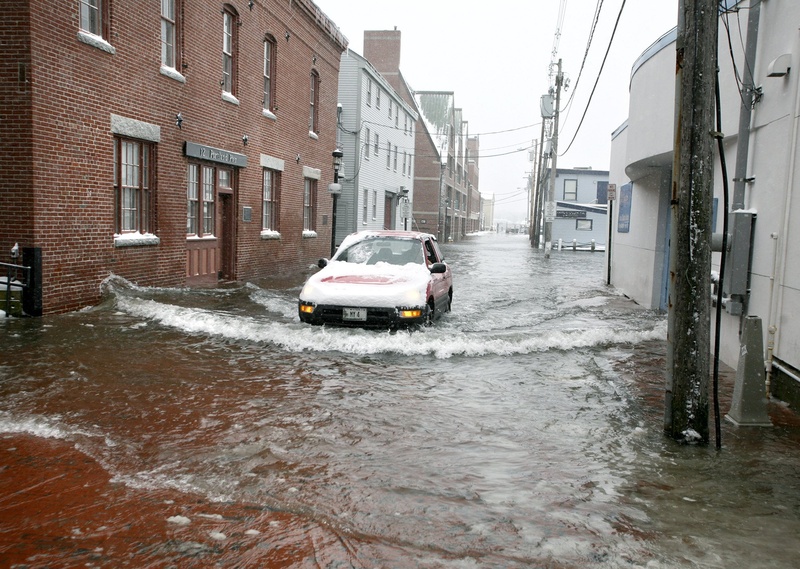PORTLAND — Rising sea levels brought on by climate change could leave sections of Portland under water by the end of the century, including the city’s wharfs and piers, Commercial Street, Marginal Way and sections of the Bayside, Back Cove and Stroudwater neighborhoods, according to a new risk analysis completed for the city.
Although scientists are unsure how much sea levels will rise, communities should start planning now for possible scenarios, from a 1-foot to a 6-foot rise, said the study’s author, Peter Slovinsky, a marine geologist at the Maine Geological Survey.
Slovinsky on Wednesday will present his study to a City Council panel, the first step in a multi-year process to develop an action plan for mitigating potential damage.
Last summer, the City Council passed a resolution supporting the development of a Sea-level Rise Adaptation Plan.
The plan could involve infrastructure improvements and adopting land-use rules, such as requiring that new buildings in low-lying areas be raised off the ground.
On Feb. 24, Sam Merrill of the New England Environmental Research Center will present a study focusing on the Back Cove area. The study looks at the financial impacts of sea-level rise under several scenarios, including one in which the city makes no changes at all.
Other communities working on adaptation plans include South Portland, Scarborough, Old Orchard Beach, Saco, Kennebunk, Biddeford, York, Ogunquit and Kittery.
The planning initiative, launched five years ago, is being funded by the federal National Oceanic and Atmospheric Administration through the Maine Coast Program, a state program that works with local, regional and state agencies to manage coastal resources.
Wednesday’s meeting will mark the beginning of a community conversation about how to plan for the effects of rising seas, said City Councilor David Marshall, who chairs the council’s Transportation, Energy and Sustainability Committee.
He said the effort will involve months of policy discussions involving the public, city staff, the City Council and the Planning Board.
He said the city might eventually change building rules in some parts of the city. For example, one coastal city in Germany now requires that buildings in high-risk areas be built several feet off the ground to reduce the amount of damage from rising sea levels, Marshall said.
Municipal officials are not the only ones looking at this issue. The mortgage company for Whole Foods required that the Bayside supermarket be built 2 feet above the flood plain, said Ian Houseal, the city’s sustainability coordinator.
There is evidence that the sea levels on the Maine coast are already rising. Sea level measurements have been recorded at the Portland tide gauge since 1912, one of the longest records in the country.
Data indicate that sea level has risen about 7.2 inches over the past century.
This trend mirrors the measurements of global sea level changes over the past 100 years, Slovinsky said.
The highest recorded water level at the Portland tide gauge was 4.2 feet above mean high water, recorded during a blizzard in February 1978, the city’s most recent “100-year storm.” In five decades, Portland could be experiencing that same high tide mark every year, Slovinsky said.
To create his maps of the city, Slovinsky used topographic data collected from laser instruments mounted on precisely navigated aircraft.
Even if seas do not rise as much as scientists now predict, Slovinsky said, the planning would still be valuable because it would help the city prepare for the next 100-year storm, such as the 1978 blizzard. Economic losses from the storm in New England, including damages directly caused by the storm and costs of snow removal, approached $1 billion.
Staff Writer Tom Bell can be contacted at 791-6369 or at: tbell@mainetoday.com
Send questions/comments to the editors.



Success. Please wait for the page to reload. If the page does not reload within 5 seconds, please refresh the page.
Enter your email and password to access comments.
Hi, to comment on stories you must . This profile is in addition to your subscription and website login.
Already have a commenting profile? .
Invalid username/password.
Please check your email to confirm and complete your registration.
Only subscribers are eligible to post comments. Please subscribe or login first for digital access. Here’s why.
Use the form below to reset your password. When you've submitted your account email, we will send an email with a reset code.